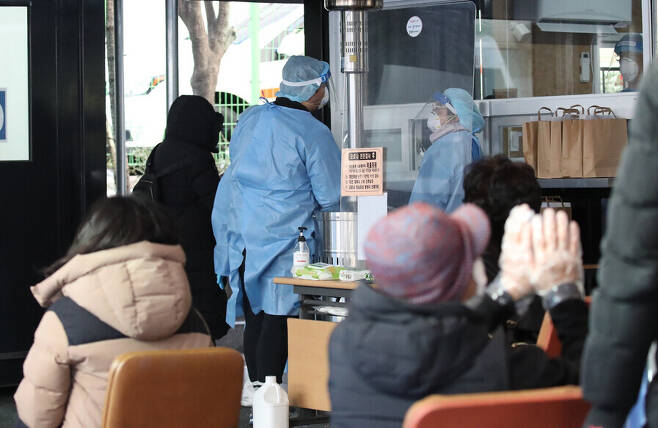S. Korea's COVID death total exceeds 1,000 just 321 days after its first fatality
전체 맥락을 이해하기 위해서는 본문 보기를 권장합니다.
Commenting on the reason for the rise in deaths, Lee Sang-won said, "One of the characteristics of COVID-19 is that the fatality rate rises sharply in the population aged 60 and over."
Commenting on the rise in people seeking out the anti-inflammatory dexamethasone, the MFDS explained, "Since inflammation is an immune response, anti-inflammatories can make COVID-19 symptoms worse because they often suppress immune responses. Any COVID patients looking to take an anti-inflammatory must consult a physician and receive the proper prescription."
이 글자크기로 변경됩니다.
(예시) 가장 빠른 뉴스가 있고 다양한 정보, 쌍방향 소통이 숨쉬는 다음뉴스를 만나보세요. 다음뉴스는 국내외 주요이슈와 실시간 속보, 문화생활 및 다양한 분야의 뉴스를 입체적으로 전달하고 있습니다.

South Korea reported 715 new cases of COVID-19 on Jan. 5. While disease control authorities noted the country’s first decline since the third wave began, the cumulative death total surpassed 1,000, just over 320 days after its first fatality.
According to the Korea Disease Control and Prevention Agency (KDCA), 672 of the infections were domestic transmissions, while the remaining 43 were from overseas. The daily caseload was down by 305 from 1,020 cases the previous day. Lee Sang-won, director of the KDCA’s epidemiological research analysis team, remarked it was the “first downward trend observed during the third wave” during a daily KDCA briefing.
“The reproduction number last week was below 1,” Lee noted. The reproduction number indicates how many additional infections an original carrier causes.
But while the increase in cases has been dropping off, deaths have risen at a sharp rate since December. On Jan. 5, 26 additional deaths were reported, bringing the cumulative total to 1,007. This comes 321 days after South Korea’s first COVID-19 death on Feb. 20 of last year. An additional 107 deaths were reported in the five days following Dec. 31, when the cumulative death total reached 900.
Commenting on the reason for the rise in deaths, Lee Sang-won said, “One of the characteristics of COVID-19 is that the fatality rate rises sharply in the population aged 60 and over.”
“Last month, a large number of patients were diagnosed in nursing homes and senior care facilities. Because so many patients were older and had underlying conditions, the number of deaths has inevitably risen,” he explained. According to the KDCA, 507 of the 1,007 total deaths to date (50.3%) have been patients infected in facilities such as nursing homes.
“This has been a case where the number of people passing away has risen in the weeks after they first exhibited symptoms, so we could see the number of deaths increasing somewhat going forward,” Lee predicted.
Meanwhile, the Ministry of Food and Drug Safety (MFDS) stressed the same day that “no actual result has been demonstrated” by hydroxychloroquine, a malaria treatment that has been the subject of a purchasing boom chiefly among senior citizens after being falsely reported as a treatment for COVID-19.
Commenting on the rise in people seeking out the anti-inflammatory dexamethasone, the MFDS explained, “Since inflammation is an immune response, anti-inflammatories can make COVID-19 symptoms worse because they often suppress immune responses. Any COVID patients looking to take an anti-inflammatory must consult a physician and receive the proper prescription.”
By Suh Hye-mi and Choi Ha-yan, staff reporters
Please direct comments or questions to [english@hani.co.kr]
Copyright © 한겨레. All rights reserved. 무단 전재, 재배포 및 크롤링 금지.
- 경찰청장, ‘정인이 사건’ 대국민 사과… “양천서장 대기발령”
- 상상이 안된다…‘막강한파 시작’ 8일 서울 체감 영하 24도
- “영국 변이 바이러스는 새로운 대유행의 전조 가능성” 경고
- MLB 입단 김하성 “우승 목표…신인왕도 타고 싶다”
- 미국 민주, 상원 다수당 되나…조지아주 결선투표 우세
- [유레카] 아이들 피를 먹고 자라는 ‘아동복지법’ / 김은형
- 파키스탄, 성폭력 피해 여성에 대한 ‘성경험 유무 검사’ 위헌 결정
- 훈제 연어는 모두 수입산? ‘강원도산 대서양연어’ 시대 성큼
- ‘레깅스 촬영’ 무죄→유죄…대법 “분노·모멸감도 성적 수치심”
- 스타 동물 자이언트판다 그늘서 반달곰 운다